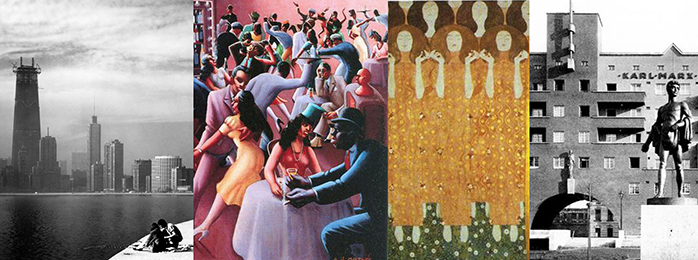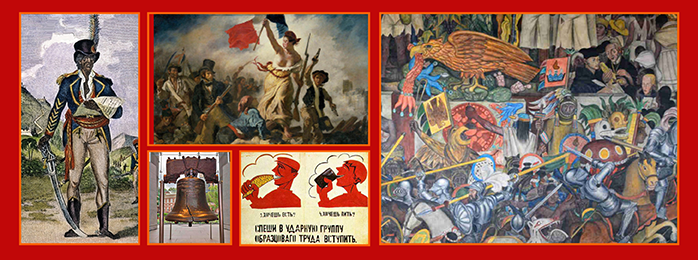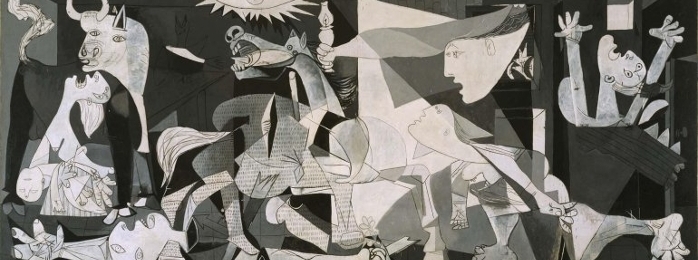Past Global Humanities Labs
Past offerings of the Kaplan Institute's Global Humanities Lab investigated international humanities topics through experiential learning and offsite research in Mexico City, Madrid, Vienna, and Istanbul.
Fall 2018
REVOLUTION
HUM 310-6 and English 385
Associate Professor John Alba Cutler (English and Latina and Latino Studies Program)
How have revolutions shaped the modern world?
How have artists, writers, historians, and musicians participated in, memorialized, and critiqued revolutionary movements?
This course will take a comparative approach to the study of the modern revolution, beginning with the Mexican and Russian revolutions of the early twentieth century, then moving back in time to the American, Haitian, and French revolutions. Drawing from a variety of humanities disciplines, we will seek to understand how revolutionary movements begin, the contingencies of revolutionary action, and what happens when revolutions become institutionalized into state apparatuses.
Course enrollment was by application; criteria for selection included qualities of intellectual curiosity, academic excellence, and maturity.
Travel to Mexico City
This small-enrollment, discussion-based seminar met for the duration of the fall quarter, and included a mandatory class trip to Mexico City to visit a variety of sites associated with the Mexican Revolution. The dates of the trip to Mexico City were September 10-15, 2018.
Costs and financial aid
Roundtrip airfare from Chicago to Mexico City, as well as shared-room lodging in Mexico, activity fees, and ground transportation, were provided directly by Northwestern. All undergraduate students were welcome to apply for this course, regardless of their financial means.
Spring 2017
PICASSO
HUM 310-6 and Art History 390-0
Professor Christina Kiaer (Art History)
The most famous artist of the twentieth century, Picasso is synonymous with the idea of modern art. Examining his work from his early scenes of bohemian Paris to his invention of cubism, his association with the surrealists, his famous protest mural Guernica of 1937, and his later political mural projects, we will ask: What makes Picasso such a powerful sign of the modern, continuously venerated in museums, scholarship and popular culture? This small-group, discussion based seminar will examine both his endlessly inventive formal experimentation—flirting with, but never fully embracing, abstraction—and the continuing resonance, in spite of feminist and postcolonial critiques, of his images of intimacy, interiority, and sexuality, as well as terror and atavistic violence.
Course enrollment was by application, with the aim to include a mix of students from both art history and non-art history backgrounds. Criteria for selection included qualities of intellectual curiosity, academic excellence, and maturity.
Travel to Madrid
This course met for the duration of the spring quarter, and included a mandatory class trip to Madrid, Spain over Memorial Day weekend (May 25-30, 2017) to see the special exhibition “Pity and Terror in Picasso: The Path to Guernica” at the Reina Sofia Museum.
Costs and Financial aid
Roundtrip international airfare from Chicago to Madrid, as well as shared-room lodging in Madrid, was provided directly by Northwestern. All undergraduate students were welcome to apply for this course, regardless of their financial means. If a student was accepted into the course and needed assistance with the out-of-pocket costs or passport fees for the trip, they could apply for the University’s Katz Enrichment Fund.
This trip was co-sponsored by the Office of the Dean of Weinberg College, the Elizabeth and Todd Warnock Gift to the Department of Art History, and the Kaplan Humanities Institute.

Spring 2017
CHARTING MODERN CITIES: VIENNA AND CHICAGO
HUM 310-4
Associate Professor Anna Parkinson (German and Critical Theory; affiliate in Gender and Sexuality Studies and Jewish Studies)
How is a city a measure of culture? What do we focus on when studying cities?
In this course students explored the distinctive histories and material cultures of two modern cities: Vienna and Chicago. In Vienna, we encountered ideas and artworks from the fin-de-siècle Vienna Modern at the heart of Central Europe, through to current political cultures of human rights and migration. In the US-American context, students traced Chicago’s brand of modernity exemplified in the history of urban planning and architectural styles, as well as domestic and transnational migration’s impact on art and social movements.
In tandem with excursions, students drew on interdisciplinary approaches from urban studies, literary and film studies, sociology, art history, philosophy, psychoanalysis, political science, intellectual history, and architecture as they sought answers through their research to the questions: how is the city constituted as an object of analysis; and how does a city shape—and, simultaneously, is shaped by—its inhabitants?
This course brought students to Vienna, Austria (March 18-25, 2017). The Kaplan Institute provided transportation and lodging for all students.
This Global Humanities Lab was co-sponsored by the Buffett Institute for Global Studies.

Fall 2015
ART, POLITICS, PUBLICS—ISTANBUL AND CHICAGO
Professor Jessica Winegar (Anthropology)
What is a public? What are the politics of constituting a public? How might this differ across time and space?
This course explored how artists — and indeed art itself — work to create publics through politics of different scales. Students were able to address these questions through actual experience of these different scalar politics, as we traveled to the international Istanbul Biennial, visited nation-oriented museums in Istanbul and Chicago, engaged with street art in Istanbul, Chicago, and Evanston, and engaged in dialogue with artists in all three locations. We complemented this research with a range of interdisciplinary readings on how publics form in relationship to objects’ agency, human and non-human networks, space, media, social hierarchies, political projects, and institutions. Special attention was paid to the relationship between arts and publics in the revolutionary movements linking the Middle East and the U.S. Ultimately, the course sought to unsettle the definitions of art, politics, and the relationship between the two in this contemporary era of intensified global circulations and inequalities.
This course brought students to the 2015 Istanbul Biennial from September 9-16, 2015.
The Keyman Program of the Buffett Institute for Global Studies and the Kaplan Institute for the Humanities provided transportation, lodging, and a stipend for all students to travel to Istanbul.
For more information about the Kaplan Institute's Global Humanities Lab, please contact Tom Burke at thomas.burke@northwestern.edu


